Rajgir was the capital of the ancient Magadha Empire and the spiritual birthplace of Buddhism & Jainism.
Rajgir – The first kingdom at the dawn of history
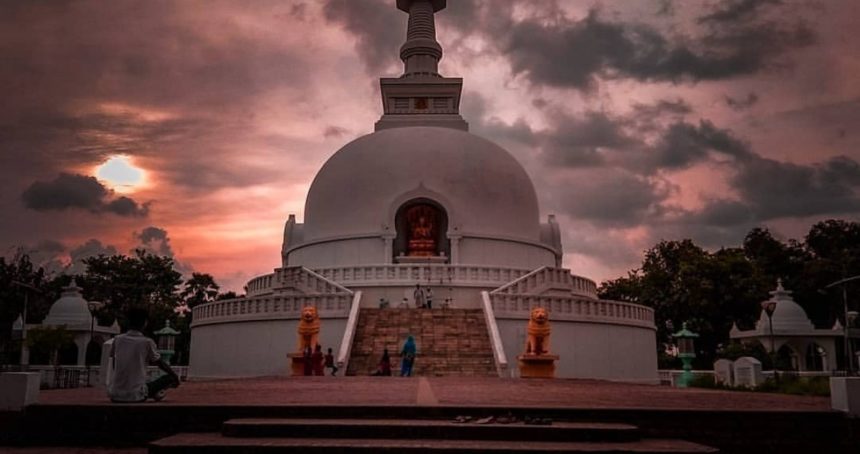
Dawn of humanity
Rajgir, the capital of the ancient kingdom of Magadha is situated in the Nalanda District of Bihar. Rajgir is a breathtakingly scenic place with hills all around safeguarding the valley from all sides. The natural protection followed by good vegetation and weather must have made this place a natural choice for the rulers to make this site their capital and seat of power.
Rajgir is the present name of this ancient site. It has been known by various other names dating back to antiquity. ‘Vasumati’ was the oldest name and is ascribed to Vasu, son of Lord Brahma, who is said to have laid the foundation of this city. The name ‘Brihadrathapur’ comes from the Puranic traditions and The Mahabharata which mention that king Brihadratha and his dynasty ruled this place for 1000 years. The name ‘Kusagrapura’ has its roots in the kusa grass that grew abundantly in this area. The more recent and popular names have been ‘Girivraja’ and ‘Rajgriha’. Girivraja denotes the geographical identity of this terrain that has hills all around. Rajgriha denotes the house or seat of the raja/ruler.
Mahabharata time
In the Mahabharata, Rajagriha was the capital of the mighty king of Magadha, Jarasandh. Magadha was a huge kingdom in the eastern part of India from ancient times, even when the main political activity was centred in and around Hastinapur, near present-day Delhi. According to legend, Jarasandha was born as two separate half bodies and a demoness named JARA joined the parts to make the child whole again. There is a temple commemorating her called Jara Devi Mandir. The present temple is modern and has been constructed over the ruins of an old one. The main deity within the sanctum is worshipped as Goddess Jara Devi, the Goddess of Old Age.
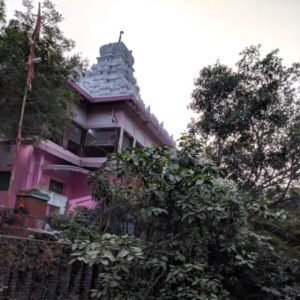
(Jara Devi Mandir)
Jarasandh ka Akhara (wrestling ground)
Jarasandha was a great warrior king and he had constant fights with Krishna. He attacked Krishna multiple times in his stronghold of Mathura and in the end, Krishna fled Mathura to establish his kingdom at the seaport of Dwarka, on the western tip of India. Krishna was called Ranchhordas (one who leaves the battlefield) after this event in his life. There is a place identified as Jarasandh ka Akhara (wrestling ground) where the beige coloured soil is said to be a remnant of the Akhara where the soil was treated with milk to prepare the ground for wrestling duels. The ASI has built a stone wall around the raised Akhara to protect it. It is a fascinating site and very scenic.
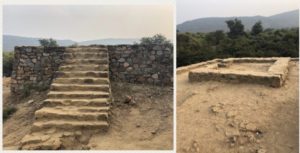
(Jarasandh ka Akhara)
Chariot wheel marks
Krishna brought the Pandavas to Rajgir and challenged Jarasandh for a wrestling duel with Bhima, the mightiest Pandava warrior. Jarasandh accepted the challenge and there was a deadly duel and in the end where Bhīma was able to kill Jarasandha, bringing the downfall of the mighty Magadha king. There are intriguing wheel marks on a bed of stones which are called the mark of Chariot wheels. According to local belief, these marks were made by Krishna’s chariot when he came here. The marks are uncanny in their similarity to what can only be made by a moving chariot, as the spacing is eerily constant (including the curves), highly improbable to have been formed naturally. At first glance, it appears as if the marks are made on mud. But when you touch the ground, it is hard as a rock. Could it be that Krishna’s Chariot made marks on the mud due to speed and power of the chariot and his devotees ensured that the marks on the ground would not be touched so that it stays till posterity! In that case, the marks have withstood thousands of years.
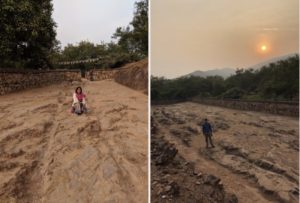
(Chariot wheel Marks)
On one side of these wheel marks, there are scattered inscriptions in the ‘Shankh Lipi’ (conch script). This name has been given as at first glance it appears stylised in the form of conch shells. This Script has not been deciphered till date.
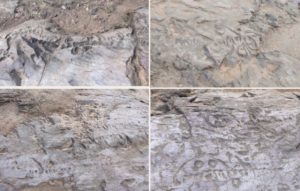
(Shankh Lipi inscriptions)
With the dawn of so-called evidenced History on the Indian Sub-continent, it was Rajagriha that was at the forefront as the capital of the mighty Mahajanapada of Magadha (almost 2600 years ago). This powerful city witnessed the formative phases of the evolution of the political structures such as that of State and Empire in the Indian Sub-Continent along with two great religious movements – Buddhism and Jainism. During this period Nalanda was a suburb of Rajagriha. The capital of the Magadha Empire shifted to Pataliputra only after mid-5th Century BCE but Rajagriha continued to be the political centre of the geographical area of the present-day Nalanda district till the early medieval period. The intellectual limelight shifted to Nalanda once the Nalanda University gained prominence as a place of learning.
Francis Buchanan, a medical doctor under the East India Company and also a geographer was the first modern explorer to visit Rajgir during the beginning of the 19th Century and report the existence of ruins of monasteries, stupas, caves, fortification walls and several Hindu and Buddhist sculptures. Buchanan was followed by Alexander Cunningham, who further excavated and unearthed mounds to recover ancient constructs. They used the scholarly works of famous Chinese Travellers like Fa Hien and Hiuen Tsang to substantiate their findings. The explorers and archaeologists have taken cues from these Buddhist works to identify other sites too.
A remarkable feature of Rajgir is that archaeological finds show a continuous history from the Palaeolithic period right up to the present era. Palaeolithic tools and some rock paintings have been discovered in the Jethian Valley of the Rajgir Hills. These findings have a prehistoric context although their exact dates have not been determined.
During his search for enlightenment, Buddha had visited Rajgir. After his enlightenment, Buddha gave his first sermon at Sarnath and then came to Rajgir for an extended stay. It was here that he gave his second sermon. Buddha’s stay at Rajgir and his association with Bimbisar and his son Ajatshatru are well documented in Buddhist texts.
Mahavir, the 24th or last Jain Tirthankara spent 14 Chaturmasyas (4-month monsoon break) in Rajgir. Mahavir is said to have given his first sermon on the Vipalachal Hill at Rajgir.
Cyclopean wall
On entering the town of Rajgir, one cannot miss the stone walls that keep appearing on both sides – sometimes near the road and sometimes on the hills. On sighting these walls you will feel that you have entered into an ancient kingdom that is protected by the hills and these ‘Cyclopean Walls’. These walls form an outer continuous fortification that covers the high ranges of the five hills along with the valley, which comprised the old city of Rajgir. This is a stone masonry wall built without mortars that extends up to 48 kilometres and is the most distinguished antiquarian remain of this ancient city.
Besides the prominent Cyclopean wall, there is an inner fortification wall that encloses the core of the original ancient city. It has a periphery of 7.5 kms and is built of earth and pebbles. The walls are in ruins but at places, it reaches a height of 10 metres. There are remains of subsidiary walls as well that served another purpose besides fortification. These walls have well-marked gaps representative of ancient gate sites. No date has been designated for these ruins.
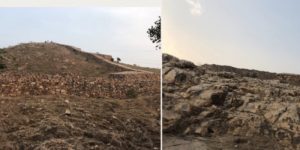
(The Cyclopean walls)
From the various names given to Rajgir, its geographic identity retains its prominence even in the writings of foreign scholars, who had come to learn first-hand about the tenets of Buddhism. Fa-Hien, a Chinese Buddhist monk, who travelled to India in 399 CE described the topography – the “five hills form a girdle like the walls of a town,” which is an exact description of Rajgir. There are writings by other travellers, who came to Nalanda & Rajgir and described the town along with the terrain and name of the prominent hills. Present day names are Ratnagiri, Vaibhargiri, Vipulagiri, Udayagiri and Sonagiri.
Sonbhandar -Bimbisar era cave
The Sonbhandar is one of the most intriguing sites at Rajgir due to the myth that there is a hidden door inside the western cave that leads to Bimbisar’s hidden wealth. Spoiler – There is no such door even though there appear to be chiselled marks outlining a door inside the bigger cave.
Sonbhandar consists of two man-made rock-cut caves next to each other on the lower parts of the Vaibhara hill that represent one of the earliest specimens of cave architecture in India. It is a beautiful site that once had a pillared veranda, which was destroyed during the earthquake of 1934.
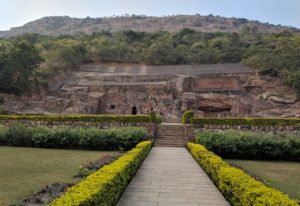
(Outer view of Sonbhandar)
Inner structure
The inner area of the western cave has a rectangular base and the walls taper up at the top. There is a window carved out into the outer wall for sunlight. To admire this human feat one must remember that the solid rock has been carved out to create this shapely inner area. The walls have carvings that have faded over time. A Jain image is somewhat visible on the wall. Shankh script at certain places is also visible. Short epigraphs are present on the inner walls, door-jams and front walls that have been dated to the Gupta era between the 2nd to 4th Century CE. The structure of this cave is similar to the Barabar Caves but lacks in quality of polish on the walls. Myths take this cave back to the days of Bimbisar but historians claim that the earliest date could be during the Ashokan era i.e. 3rd Century BCE.
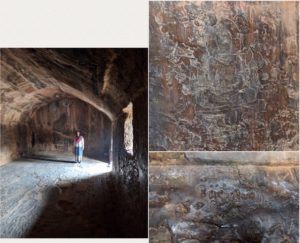
(The western Sonbhandar cave)
The eastern cave has lost its roof area, but the walls retain their remarkable Jain sculptures. It is unfortunate that all the sculptures have been systematically defaced by the invaders during the medieval ages. From the left, there are images of Padmaprabha, Jina, Ajitanatha, Parshavanatha and Lord Mahavira. These carvings have been dated to the 5th Century CE.
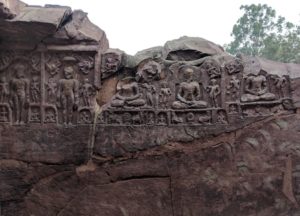
(The Jain sculptures)
Maniyar Math
Maniyar Math is the most distinguished extant temple structure within the inner part of the old city of Rajgir. It was Alexander Cunningham who excavated the mound at Maniyar Math to expose brick-lined well structures. During the beginning of the 20th century, Bloch further traced the exterior of the circular structure to discover beautiful stucco sculptures of various Hindu deities including six stucco figures of Nagas and Nagins that makes this an important Naga or snake cult worship site. It has been dated to the 1st century CE and much of the work appears to be done during the early Gupta period.
The compound of Maniyar Math has remains of various ruined structures. What is recognisable are 3 similar sized wells on one side of the main temple. These wells are walled with stone and mortar.
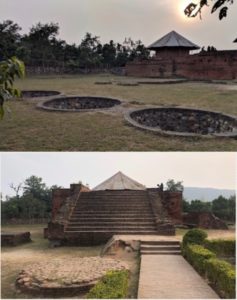
(The three wells; stairs that lead to the temple and remains of other brick structures)
The main temple structure is a cylindrical, hollow, brick structure with a circular pathway around it. The outer wall has traces of stucco work only in a few places. There is no deity inside the Garbhgriha but a lighted diya (oil lamp) is kept in the centre – the place of the deity. As I stood in front of the diya with folded hands, I was taken back to the time when I had visited my mother’s ancestral village (in Nalanda District). The extended family house had a room called ‘Seera Ghar’ or the house of God. The room had plain walls with two stands, one on which puja items were kept and another on which a lighted lamp was kept. There were no deities in the room. One had to take the names of the ‘kul Devi and kul Devtas’. Different families had different deities such as Bhairon Baba, Parmeshwari, Jagadamba and more common deities such as Hanuman, Ganesh and Nag deva. Maniyar Math felt like a ‘Seera Ghar’. Probably the currently prevalent concept of worshipping family deities (without any statues) inside the family home, was a survival mechanism in the face of large scale desecration by the marauding barbarians during the medieval period.
This could be the oldest surviving extant Hindu Temple recovered in India till date.
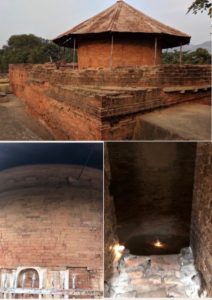
(The cylindrical temple structure and the place of worship)
Ajatshatru era fort and its remnants
There are remnants of a fort that is on the eastern side of the main road when travelling towards the Venuvan area. This fort was built by Ajatshatru (son of Bimbisar), who ruled Magadha between 492-460 BCE. Bimbisar and Ajatshatru were contemporaries of Buddha and Mahavira, who frequented Rajagriha during that period. A portion of the stone and mortar base of the fort is visible with some pillars on the top. The pillars are a later addition.
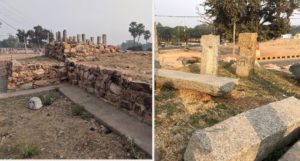
(Remains of Ajatshatru Fort)
Bimbisar jail
Bimbisar ruled Magadha with capital at Rajagriha from 558-492 BCE. He belonged to the Haryanka dynasty and is known for being a strong ruler who annexed Anga to the Magadha kingdom and laid the foundation for a huge empire. He had further expanded and strengthened his empire via marriage alliances. He got Kashi in dowry, while Kausala, Vaishali, and Madra (Punjab area) became allies.
Bimbisar was a patron of both Jainism and Buddhism. The Jain texts mention him as Shrenik and that he became a devotee of Mahavir also. Buddhist scriptures mention that Bimbisar met Buddha before Buddha attained enlightenment. He later became an important disciple and is said to have attained a certain degree of enlightenment.
Buddhist tradition mention that Ajatshatru had imprisoned his father Bimbisar in jail and became the ruler of the Magadha Empire. This jail is said to face the Griddhakuta peak, where Lord Buddha would sit in meditation. Bimbisar spent the last days of his life in this jail from where he could have the satisfaction of viewing Griddhakuta. It is believed that the square stone masonry structure from where the Griddhakuta can be viewed was Bimbisar’s jail.
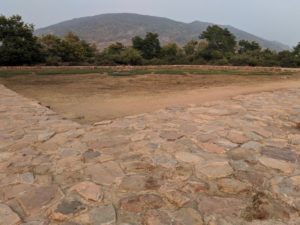
(Bimbisar’s jail)
Griddhakuta (this is a connecting hill of the Ratnagiri Hill)
Griddhakuta is a hill that has been considered the most sacred site in Rajgir from the point of view of Buddhism. Bimbisar is believed to have built a stone-paved pathway that takes one to the top of the hill. Buddha used to meditate here and also delivered the Prajnaparamita Sutra and the Lotus Sutra. There are two caves along the pathway that is said to be the dwelling sites of Lord Buddha’s disciples Ananda and Mougdalayana. These stone dwellings were seen by the traveller Hiuen Tsang in the 7th century CE. There are ruins of a brick monastery of which Hiuen Tsang has given a detailed account. There are remains of several stupas on the sides of the pathway.
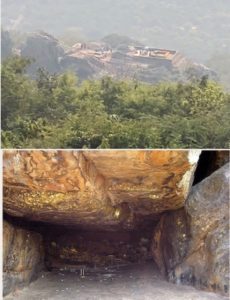
(The remains of the brick-built stupa and one of the cave dwellings on Griddhakuta)
Jivak-Aamravan Vihara (The home at the Mango Grove of Jivaka)
Jivaka was a royal physician in the court of Bimbisar and Ajatshatru. He had a mango grove just below the Griddhakuta hill that he presented to Lord Buddha and even constructed a monastery for him. Jivaka is said to have treated Lord Buddha in this monastery after he was injured from a fall caused by Devadutta on the Griddhakuta hill. Devadutta was a relative of Lord Buddha and had parted ways by forming his own Sangha.
One notices extensive stone masonry ruins and rubble at this site. The remains of stone walls are oblong in shape denoting rooms. The stupa is not present today. It is fascinating to just stand and admire the place and imagine monastery rooms surrounded by mango trees; the Physician Jivaka taking care of patients and even Lord Buddha under the canopy of trees.

(Ruins of the Jeevak-Aamravan)
Vishwa Shanti Stupa
The Vishwa Shanti Stupa has been built on top of the Ratnagiri hills by the Japanese government and Buddhist community with the assistance of the Indian government in 1969. It is one of the 80 such stupas built throughout the world. This Stupa is a symbol of non-violence along with the teachings of Lord Buddha. The architecture of most of these Stupas is similar in that they are white domed constructs with marble floors and Lord Buddha represented on the four sides of the dome.
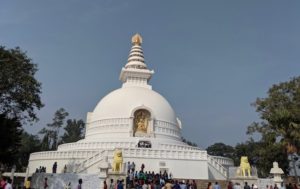
(Vishwa Shanti Stupa)
The Shanti Stupa can be reached either by climbing the Ratnagiri Hill on foot or by taking the ropeway. It is a very peaceful sight and the white monument shines from afar. The four sides of the stupa depict Lord Buddha in the four phases of his journey. The gold statues stand out for their detailing. The 4 phases of Buddha’s life represent birth, enlightenment, preaching and death (mahaparinirvana).
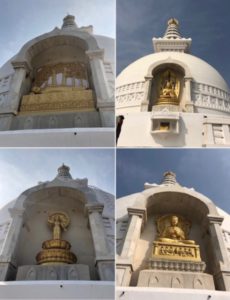
(Four statues of Lord Buddha depicting stages of his life)
There is a Buddha temple dedicated to Saddharma Pundarika Sutra (the lotus sutra) on one side of the Shanti Stupa. Buddhist monks continuously chant ‘Om Nam Myoho Renge Kyo’ (literal translation – Devotion to the law of the Lotus Flower Scripture) to the beat of the drum. These are Japanese words but chanted like a Sanskrit mantra. This chant was created by a Japanese Buddhist teacher Nichiren in 1253 CE and the sutra was originally in Sanskrit and later on was translated into various languages. One feels really at peace with the soothing sounds of the drumbeats.
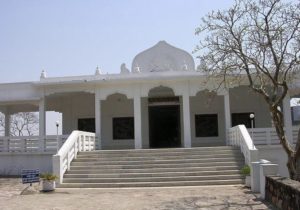
(Buddhist Temple)
Venu van
Venuvan was a bamboo grove that had been given to Lord Buddha by Bimbisar so that he and his disciples could meditate. Venuvan area was along the east of the River Saraswati although today the river is not visible. Venuvan is considered the very first Buddhist monastery site as it was here that Buddha would bathe, meditate and preach before climbing up to the Griddhakuta hill. The Karandak Nivapa water tank where Buddha bathed still remains. These sights are of much significance as it shows how the Magadha ruler respected Buddha and helped him find his path to peace. The water tank is serene and one can sit there for hours as the surroundings induce calmness. While walking around the peaceful pond, one can easily imagine the time 2600 years ago when Buddha walked these paths in solitude.
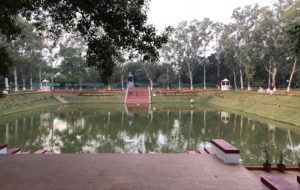
(Venu Van)
The Japanese and Thai Governments have constructed new stupas and Buddhist structures within its serene surroundings enhancing the spiritual effect.
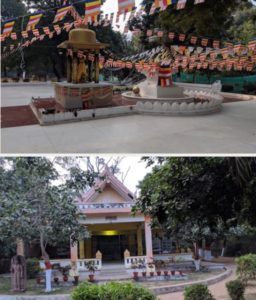
(Buddhist structures and temple made by the Japanese and Thai governments in the Venuvan complex)
Japanese temple near the Venu Van
Not far from Venuvan there is a Japanese temple which is a pillared hall with a white statue of Lord Buddha sitting in the centre. Devotees can sit inside this temple and pray. A huge statue of meditating Lord Buddha sits just outside this temple.
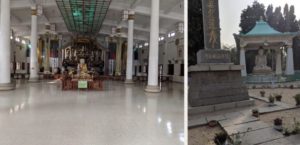
(The Japanese temple)
The hot water springs
Rajgir is famous for its hot water springs where tourists throng, especially during the winter months. There are numerous hot water springs with the Saptadhara (seven streams) and Brahmkund being the most famous. The spouts have been shaped like gargoyles and the water flows out of the mouth of these mythical creatures. The water from these spouts meets at the Brahmkund, where devotees take holy dips. These springs are at the foot of the Vaibhara Hill. This is a holy site for the Hindus, Buddhist and Jains. The water is said to have medicinal properties and it was here that even Buddha and Mahavira spent a lot of time. There are statues of the Saptarishis (seven sages) – Vashishth, Vishvamitra, Bhardwaj, Atri, Jamdagni, Agastya and Gautam and each spout is associated with one of them.
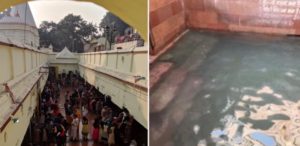
(Seven Springs and the Brahma Kund)
Temples in the kund area
The area around the hot water springs has been considered holy since time immemorial. All the religions having presence in Rajgir had their presence in this locality. There was a Buddhist Vihara during the peak of Buddhism in the Magadh kingdom but all monuments of antiquity lapsed into ruins and have been revived after the discovery of its heritage. At the location of springs, there are multiple temples paying homage to almost all deities of Hinduism. The most prominent temple is the Laxmi Narayan temple worshipping Lord Vishnu and Devi Lakshmi. There are other shrines worshipping Shiva in various forms as Somnath, Mahakaleswar, etc., and even Hanuman has a shrine dedicated to him.
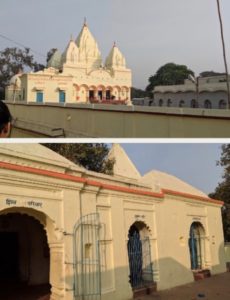
(The Hindu Temples)
Sites on Vaibhara hill
Just above the hot water springs, there is a unique construction in the shape of a raised square platform made up of rocks stacked without mortar. It is known by various names like Jarasandh Baithak, Pippali cave, etc. Apparently, it was a military outpost as its construction matches that of the Cyclopean wall. This platform has a perfectly even top level and it must have been used as a community gathering place in ancient times. As per the accounts of Chinese travellers Fa-Hien and Hiuen Tsang, Buddha liked to meditate in a cave-like structure called Pippali cave. One of the main disciples of Buddha, Mahakasyapa also lived here during that time.
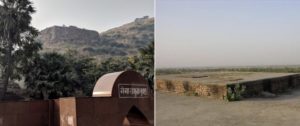
(The Jarasandh Baithak/Pippali cave; view from far and near)
Ancient Shiva temple
On top of this Vaibhara hill, there is a unique assimilation of sites related to all the three religions associated with this area. For Hinduism, there is an ancient Shiva temple which is mostly in ruins now. The legend associates its construction with Jarasandh and this brick and granite stone structure is at least a thousand years old. Multi-stage construction is evident from the ruins.
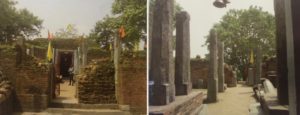
(Ancient Shiva temple)
Saptaparni caves
At the other end of this hill just below the peak, there is a set of 7 caves called Saptaparni caves. These non-descript caves hold enormous importance for the Buddhist, as this has been identified as the place where hundreds of monks congregated a few months after the death of Buddha to codify his teachings. This is also recognised as the first Buddhist council which was organised by Mahakasyapa where Buddha’s main disciples, including Anand, chanted the Sutras containing his teachings and the content of Buddhist doctrine was finalised. This is the place where Buddhism as a proper religious order may have taken shape after the demise of Gautam Buddha. Notwithstanding the small entrance areas to these caves, the inner part of the caves is surprisingly spacious.
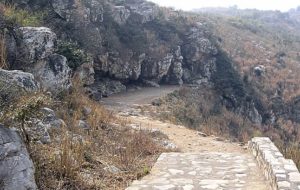
(Saptaparni Caves)
Ruins of a Jain monastery/temple
On top of the Vaibhara hill, there are impressive ruins of a Vihara where living quarters and study/meditation/worship areas are clearly visible. The unique aspect of this Vihara is that it was clearly a place for Jain monks and the statues of Jain Tirthankaras are still available in this campus in various alcoves and niches. This is one of the earliest and a very rare case of a Vihara traceable to Jain monks. It dates back to more than a thousand years ago.
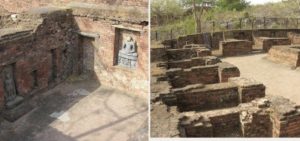
(Jain temple and Vihara)
New Jain temples
On the way to the Saptaparni caves, there are seven temples built by Jains to commemorate the various association of this hill with their religion. These are located in isolated areas and only occasional pilgrims on the way to Saptaparni caves happen to visit these serene shrines. One of the temples is for Digambar Jains, with a beautiful statue of Lord Mahavira and another important temple is of Munisuvrata swami who is recognised as the twentieth Tirthankara of Jainism. Jain tradition associates his birth with Rajgir.
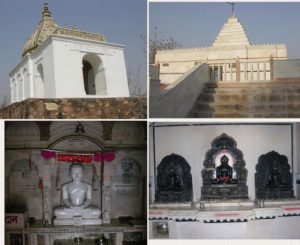
(New Jain temples)
Rajgir has been very important for Jains due to its association with Mahavira who spent 14 years here. The hills of Vipulagiri are also associated with the place from where he started his penance. It is no surprise that the hilltops are venerated by Jains and by current accounts there are no less than 26 Jain temples on the hills surrounding Rajgir.
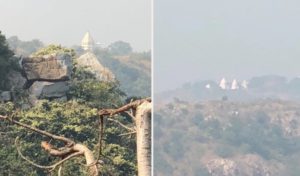
(Jain temples on the hilltops)
Veerayatan
There is a beautiful complex of Jain temples and a museum type gallery depicting Jain mythology near the Venu Van. It is called Veerayatan and it is maintained by a charitable society. The gallery has very colourful dollhouse models depicting various life events of Jain Tirthankaras and associated mythological events. Lord Indra is a prominent depiction in these displays.
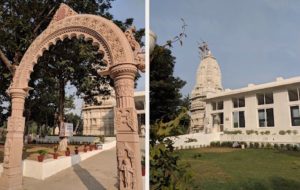
(Veerayatan)
Stupa mound on Chhatagiri Hill
On top of the Chhatagiri Hill, there is a Stupa mound. One can view this Stupa mound from the top of Ratnagiri Hill to its east. The locals call this the Ashoka Stupa but the Parinibbana Sutta states that a portion of Buddha’s relic was given to Ajatshatru, and the relics may be under this Stupa. This remote Stupa mound awaits more research.
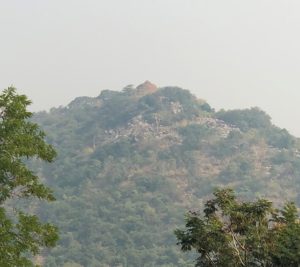
(Stupa Mound, Chhatagiri)
Un-named Stupa
A stupa has been recently excavated on the side of the main Rajgir road. No name has been given to it nor do we find the time during which it was made. This brick structure is pyramidal in style with narrow step-like structures that may have helped the devotees to climb to the top level. The identification of monuments mentioned by Hiuen Tsang and Fa Hien and other Chinese/Buddhist pilgrims has proven to be quite challenging.
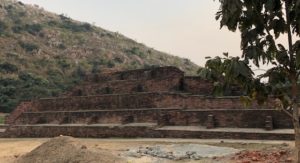
(The mystery Stupa)
There is so much mystery attached to many structures, ruins, remains in Rajgir that it makes for a most memorable trip, especially if one could imagine oneself present during the events taking place since pre-historic times – Krishna charging in on his Chariot, The wrestling fight between Bhīma and Jarasandh, Hindus worshipping at the Maniyar Math, Buddha and Mahavira meditating at various sites within the old city, Bimbisar imprisoned within a stone jail but glad that he could view Griddhakuta where Lord Buddha sat in Meditation and so much more.
Conclusion
There is no comparable place anywhere in the world which has so much historical and spiritual significance for the followers of 3 major religions. It seems as if these serene surroundings have attracted spiritual masters since the dawn of humanity.
It is such a pity that historical adversities have resulted in such a complete loss of actual records of the momentous events that have spanned over millennia at this place. Had the Universities of Nalanda, Odantapuri, Telhara, Vikramshila and others survived, there could have been so much more knowledge and understanding of this area.

Leave a Reply